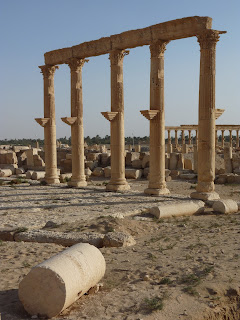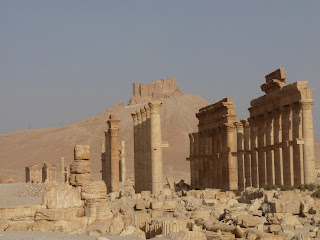Lonely planet is keen to emphasise the friendliness of the Syrian people. Well in two nights at Palmyra, an oasis town in the desert, I saw two fights, which is rather high even by London estate standards.
The first was a full scale restuarant war. As far as I could glean, restaurant A put a row of tables out in the street to feed a particular tour group. Apparently you are not allowed to put tables in the street, so restaurant B (no doubt thinking that if Restaurant A could not seat this group inside they would have a good chance of picking up the trade), went into full plate breaking mode. Crockery flying and tempers flared, lots of shoving and shouting and lets just say neither restaurant got our custom that night. And Palmyra isn't blessed with a huge number of eateries. (Actually I had tried Restaurant B at lunchtime with my room mate, and despite the two of us and one other bloke dining on his own being the only customers, they couldn't work out which order was which. So quality of service not a strong point either).
Next day I had lunch on my own at a backstreet restaurant, and out of the corner of my eye two middle-aged blokes just started laying into each other like schoolboys. They quickly drew a crowd and had to be pulled off each other. One couldn't then resist kicking the bike of his assailant in one final show of petullance. All quite fun really, but be assured I didn't click my fingers at a waiter and was very patient waiting for a bill.
Oh and Palmyra. Well as I say an oasis town. Which in Roman times was on the silk road and taxed its way to truly staggering prosperity evidenced by the ruins. It had the good fortune (from the viewpoint of posterity if not its inhabitants) to be finally destroyed by an earthquake and then buried by the desert. The main drag (ok the Great Colonnade) has largely been restored (by putting back up the columns with just a few extra bits of cementing needed), as has the theatre and some of the temples. From the look of it there is about 2 metres of sand to be excavated all around and who knows what else could be found. But maybe its best left as I don't much admire the care given. Some soldiers came along and for a lark decided to climb the monumental arch. They happily let hawkers speed their motorbikes up and down the ruins in pursuit of tourists (of whom there are not too many, kept down by a combination of remoteness and desert heat). (One hawker, having finally decided that I really really wasn't interested in buying a necklace, then circled back and asked if I was part of a group. When I had to admit in truth I was, "Where group?" followed, clearly in serch of the mother lode. Had trouble persuading him that though a group we didn't actually travel as one and were suitably scattered about.)
And our guide, who laughably claims to be an archaeologist herself, merrily pawed tombs, statues etc in museums, even right next to do not touch signs.
Anyway, have taken far too many photos, but just a lovely warm glow to the ruins in the late afternoon sun. And the ruins are so extensive. About 1.5kms down the main street. I particulary loved the theatre (which extorts the equivalent of a quid to enter), which meant I actually, for a few minutes, had the whole place to myself. Being a Roman Theatre this was not for for the production of refined Greek plays, but for fights, especially animal v human. So think less Shakespeare more WWF. But empty its really serene.
They also have a nice line in tombs, in the form of towers. Big cheeses got statues and prime spots at the bottom. Lesser lights were slotted sideways into niches in the walls, stacked floor to ceiling.
Magical site. If you can keep out of a fight.













































No comments:
Post a Comment